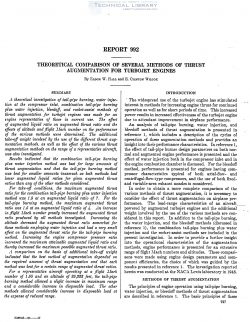naca-report-992

- Version
- 162 Downloads
- 1.24 MB File Size
- 1 File Count
- September 1, 2016 Create Date
- September 1, 2016 Last Updated
National Advisory Committee for Aeronautics, Report - Theoretical Comparison of Several Methods of Thrust Augmentation for Turbojet Engines

A theoretical inrestigation of tail-pipe burning, u'ater injec-
tion at the compressor inlet. combination tail-pipe burning
plus unter injection, bleedof, and rocket-assist methods of
thrust augmentation for turbojet engines was made for an
engine representative of those in current use. The efiect
of augmented liquid ratio on augmented thrust ratio and the
effects of altitude and flight JIach number on the performance
of the various methods were determined. The additional
take-of weight involved by the use of the difi’erent thrust aug—
mentation methods, as well as the eject- of the various thrust
augmentation methods on the range of a representatire aircraft,
was also investigated.
Results indicated that the combination tail-pipe burning
plus water injection method was best for large amounts of
thrust augmentation and that the tail—pipe burning method
was best for smaller amounts inasmuch as both methods had
lower augmented liquid ratios for gicen augmented thrust
ratios than any of the other methods considered.
For talc-oz?r conditions, the maximum augmented thrust
ratio for the combination tail-pipe burning plus water injection
method nus 1.9 at an augmented liquid ratio of 7‘. For the
tail-pipe burning method, the maximum augmented thrust
ratio was 15 at an augmented liquid ratio of 4. An increase
in flight JIach number greatly increased the augmented thrust
ratio produced by all methods investigated. Increasing the
altitude decreased the augmented thrust ratio someu‘hat for
those methods employing water injection and had a very small
eg‘fect on the augmented thrust ratio for the tail-pipe burning
method. Increasing the engine compressor pressure ratio
increased the maximum attainable augmented liquid ratio and
thereby increased the maximum possible augmented thrust ratio.
A comparison on the basis of additional take-of u'eight
indicated that the best method of augmentation depended on
the required amount of thrust augmentation and that each
method was best for a certain range of augmented thrust ratios.
| File | Action |
|---|---|
| naca-report-992 Theoretical Comparison of Several Methods of Thrust Augmentation for Turbojet Engines.pdf | Download |

Comment On This Post